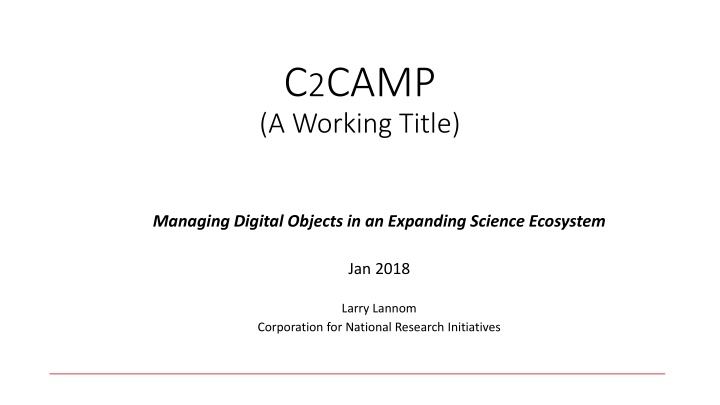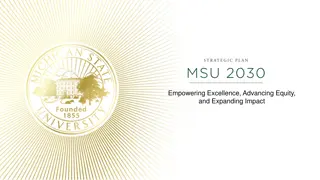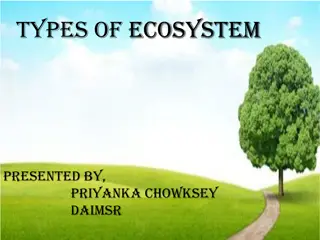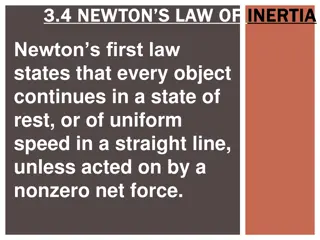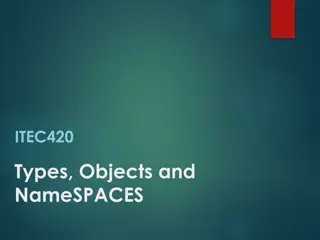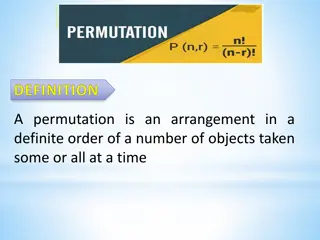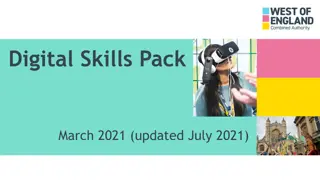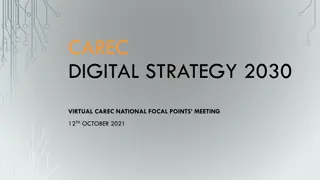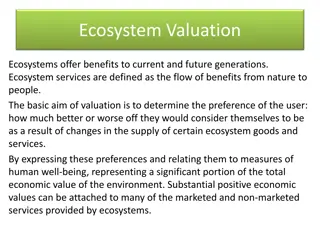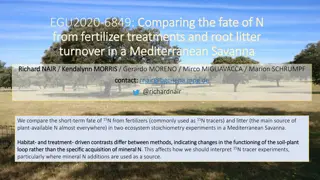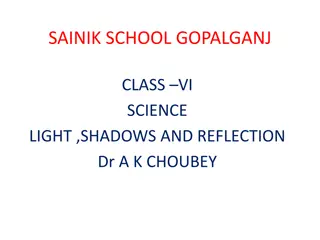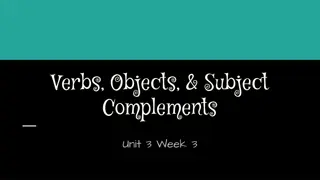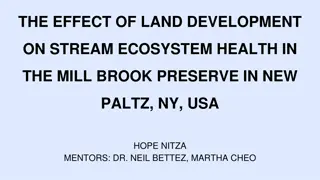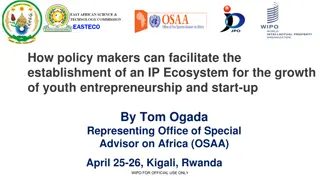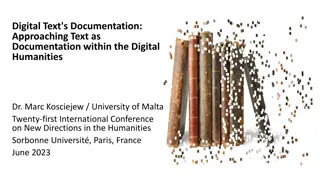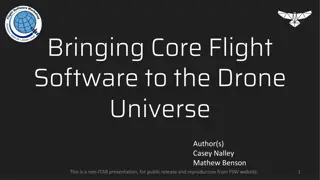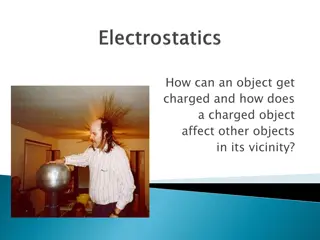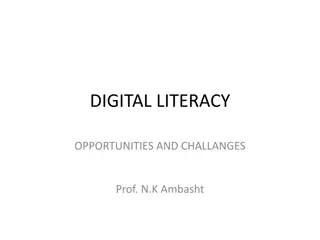Managing Digital Objects in an Expanding Science Ecosystem
Working towards a prototype distributed environment for efficient data management and sharing in a fast-growing science ecosystem, focusing on automation, common tools, and processes for data processing and access. Implementing a digital object model to address challenges in interpreting data, enabling users to combine datasets, and emphasizing the need for a common middle layer for data semantics.
Download Presentation

Please find below an Image/Link to download the presentation.
The content on the website is provided AS IS for your information and personal use only. It may not be sold, licensed, or shared on other websites without obtaining consent from the author.If you encounter any issues during the download, it is possible that the publisher has removed the file from their server.
You are allowed to download the files provided on this website for personal or commercial use, subject to the condition that they are used lawfully. All files are the property of their respective owners.
The content on the website is provided AS IS for your information and personal use only. It may not be sold, licensed, or shared on other websites without obtaining consent from the author.
E N D
Presentation Transcript
C2CAMP (A Working Title) Managing Digital Objects in an Expanding Science Ecosystem Jan 2018 Larry Lannom Corporation for National Research Initiatives
C2CAMP (Cross-Continental Collection & Management Pilot) Loose association of research groups with some agreed-upon goals Proposed multi-party distributed test bed based on open specifications across a minimal set of (mostly) existing components and interfaces allowing users to deal with Digital Objects efficiently Data producers and managers invited to prototype their work flows and other processes in the distributed test bed Solicit the creation of additional components and interfaces as needed to meet the requirements evolving from prototypic use of the test bed Demonstrate complex scientific workflows for data processing harmonized and automated across communities by using interchangeable infrastructure components and a structured resource market approach Corporation for National Research Initiatives
What Problem are We Trying to Solve? On the processing side the vast amounts of data now being collected and generated require new levels of automation. Point solutions are terribly inefficient Core data processing is the same in physics as it is in medicine We need common tools and processes for the levels at which all data is the same On the access side simply making data available (DOI to repository), challenging as that may sometimes be, is not sufficient for widespread sharing and re-use of scientific data. How can users interpret the data? What do they know other than format? Provenance? Documentation? Can they combine it with other data sets? What tools can they use? Where is the detailed metadata? We see the need for a common middle layer between clients of all kinds and storage of all kinds, allowing focus on the difficult semantics/knowledge challenges. Corporation for National Research Initiatives
What Exactly are we Proposing to Do? Implement a prototype distributed environment based on the digital object model Everything in the environment is a digital object For basic information management tasks every object can be treated the same, regardless of information content Every object has a globally unique and actionable identifier Every object is typed Every object has tightly associated metadata Every object has a query-able set of operations that can be performed on it Start with the minimal set of components and services that enable the DO model Identifiers + Resolution System Types + Type Registries DO Repositories, including repositories of metadata, aka, registries Mapping/brokering software & services to map existing data storage and management systems to DOs Digital Object Interface Protocol, implemented by DO Repositories Open the environment to as many use cases as possible to hone the core infrastructural pieces Corporation for National Research Initiatives
Global Digital Object Cloud (GDOC) ID: 843 G (object:publication) Identifier Service Identifier Service ID: 987/ Repo/Registry Repo/Registry Repo/Registry 101110010101001010 010101010101010100 010101010101010100 111110101101010111 Identifier Service Repo/Registry Repo/Registry (object:dataset) ID: 123 ID: XZY ID: 876 A A ID: HGY A (object:collection) End users, developers, and automated processes deal with persistently identified, virtually aggregated digital objects, including collections which are overlays on multiple network services which in turn are overlays on existing or future information storage systems.
Global Digital Object Cloud (GDOC) Identifier Service Identifier Service Repo/Registry Repo/Registry Repo/Registry Identifier Service Repo/Registry Repo/Registry ID: 123 which are overlays on multiple network services ID: XZY ID: 876 A A ID: HGY A which in turn are overlays on existing or future information storage systems. deal with persistently identified, virtually aggregated digital objects, including collections End users, developers, and automated processes
Global Digital Object Cloud (GDOC) These services can be orchestrated to provide an object view of underlying storage, e.g., file systems, or basic data management systems, e.g., databases. Identifier Service Identifier Service Repo/Registry Repo/Registry Repo/Registry Identifier Service Repo/Registry Repo/Registry ID: 123 which are overlays on multiple network services ID: XZY ID: 876 A A ID: HGY A which in turn are overlays on existing or future information storage systems. deal with persistently identified, virtually aggregated digital objects, including collections End users, developers, and automated processes
Global Digital Object Cloud (GDOC) ID: 843 G (object:publication) ID: 987/ 101110010101001010 010101010101010100 010101010101010100 111110101101010111 (object:dataset) ID: 123 ID: XZY ID: 876 A A ID: HGY A (object:collection) Identifier Service deal with persistently identified, virtually aggregated digital objects, including collections Repo/Registry Repo/Registry which in turn are overlays on existing or future information storage systems. End users, developers, and automated processes which are overlays on multiple network services
Global Digital Object Cloud (GDOC) ID: 843 G The resulting set of identified and well-structured objects provide a common, and constant, view and remote control management of data distributed in various locations and systems, which can change without changing the virtualized object. (object:publication) ID: 987/ 101110010101001010 010101010101010100 010101010101010100 111110101101010111 (object:dataset) ID: 123 ID: XZY ID: 876 A A ID: HGY A (object:collection) Identifier Service deal with persistently identified, virtually aggregated digital objects, including collections Repo/Registry Repo/Registry which in turn are overlays on existing or future information storage systems. End users, developers, and automated processes which are overlays on multiple network services
Global Digital Object Cloud (GDOC) All of these services exist today in one form or another, but some are not yet widely used and few are tightly coordinated and orchestrated in the way that is needed. Identifier Service Identifier Service Repo/Registry Repo/Registry Repo/Registry Identifier Service Repo/Registry Repo/Registry ID: 123 which are overlays on multiple network services ID: XZY ID: 876 A A ID: HGY A which in turn are overlays on existing or future information storage systems. deal with persistently identified, virtually aggregated digital objects, including collections End users, developers, and automated processes
Why is this a Good Idea? The Digital Object Model Simplifies the Solution Space Treat every information object the same until you have to differentiate among them to accomplish your purpose Push the current cacophony of information management and storage systems down a level of abstraction Objects are self-describing in that they carry their type information independent of their current system location The prototype will let us test the above assertions The prototype will be based on open standards and proven technology The proposed project has already gathered significant support and is coming out of the Research Data Alliance, broadly representing the international research data community Corporation for National Research Initiatives
Who Is We? Digital Object Model (CNRI) RDA Data Fabric Interest Group Reusable components, Automated Work Flows, Type-based operations Supporting Output Recommendations for Implementing a Virtual Layer for Management of the Complete Life Cycle of Scientific Data Brainstorming meeting Nov 16, 2017 Growing list of participants German Climate Center UK Natural History Museum (biodiversity) Swiss National Computing Center CNRI BRDI NCAR MPI Indiana U. Clarin FZ-Juelich CSIR Corporation for National Research Initiatives
